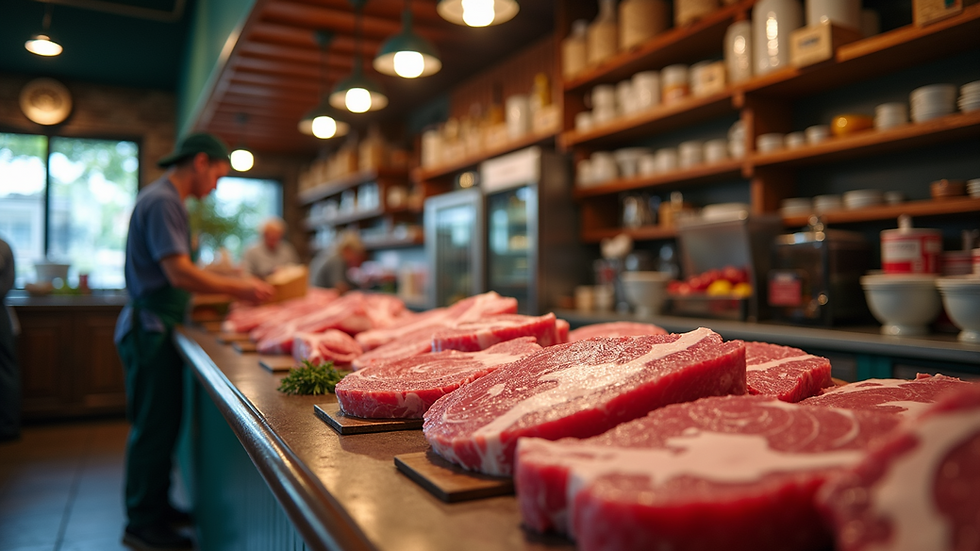Trends Shaping the Future of the Food Service Industry
- Team @ Ezy Click Answers
- Sep 8
- 4 min read
The food service market is evolving rapidly, influenced by changing consumer preferences, technological advancements, and global economic shifts. Businesses in this sector must stay ahead of these trends to remain competitive and meet customer expectations. This article explores the key trends shaping the future of the food service market, offering practical insights and examples to help industry players adapt and thrive.
The Rise of Sustainable and Ethical Food Practices in the Food Service Market
Sustainability has become a major focus in the food service market. Consumers are increasingly aware of the environmental impact of their food choices and demand transparency from food providers. This shift is driving restaurants, cafes, and catering services to adopt more sustainable practices.
Examples of sustainable practices include:
Sourcing ingredients locally to reduce carbon footprint and support local farmers.
Using organic and ethically produced food items.
Minimizing food waste through better inventory management and creative menu planning.
Implementing eco-friendly packaging solutions such as biodegradable containers and reusable utensils.
Restaurants that embrace sustainability not only attract environmentally conscious customers but also often reduce operational costs. For instance, a café that partners with local farms can offer fresher produce while cutting down on transportation expenses.
Actionable recommendations:
Conduct a sustainability audit to identify areas for improvement.
Build relationships with local suppliers and farmers.
Train staff on waste reduction and sustainable practices.
Communicate your sustainability efforts clearly to customers through menus and marketing.

Caption: Sourcing fresh, local produce supports sustainability and quality in food service.
Technology Integration Transforming the Food Service Market
Technology is revolutionizing how food service businesses operate and interact with customers. From ordering systems to kitchen automation, technology enhances efficiency and customer experience.
Key technological trends include:
Online ordering and delivery platforms: These have become essential, especially after the pandemic accelerated demand for contactless service.
Mobile apps and loyalty programs: Apps allow customers to order ahead, customize meals, and earn rewards, increasing engagement and repeat business.
Kitchen automation: Tools like smart ovens, robotic food prep, and inventory management software streamline operations and reduce errors.
Data analytics: Analyzing customer data helps tailor menus, optimize pricing, and improve marketing strategies.
For example, a restaurant using an integrated POS system can track popular dishes in real-time and adjust inventory accordingly, reducing waste and improving profitability.
Actionable recommendations:
Invest in a reliable online ordering system.
Develop a mobile app or partner with existing delivery platforms.
Explore kitchen automation tools suitable for your operation size.
Use data analytics to understand customer preferences and optimize offerings.

Caption: Digital kiosks streamline ordering and improve customer convenience.
Health and Wellness Trends Driving Menu Innovation
Consumers are more health-conscious than ever, influencing the food service market to offer healthier, more diverse options. This trend is not just about low-calorie meals but also includes dietary preferences and functional foods.
Popular health and wellness trends include:
Plant-based and vegan options gaining mainstream popularity.
Gluten-free, keto, and paleo diets influencing menu choices.
Incorporation of superfoods and nutrient-dense ingredients.
Focus on clean labels with no artificial additives or preservatives.
Restaurants and cafes that innovate their menus to include these options can attract a broader customer base. For example, a bistro adding a range of plant-based dishes alongside traditional meals caters to both vegans and flexitarians.
Actionable recommendations:
Research popular dietary trends in your region.
Collaborate with nutritionists to develop balanced, appealing dishes.
Clearly label menu items to highlight health benefits.
Train staff to answer questions about dietary options confidently.

Caption: Plant-based meals are increasingly popular in the evolving food service market.
The Impact of Delivery and Ghost Kitchens on Food Service
The rise of food delivery services has transformed the food service market landscape. Ghost kitchens - commercial kitchens that prepare food exclusively for delivery - are becoming a popular business model.
Benefits of ghost kitchens include:
Lower overhead costs compared to traditional restaurants.
Ability to test new concepts without a physical storefront.
Flexibility to serve multiple brands from one kitchen.
Faster adaptation to delivery trends and customer preferences.
Delivery platforms like Uber Eats and Deliveroo have expanded the reach of food businesses, allowing them to tap into new customer segments. However, success depends on efficient logistics, packaging, and maintaining food quality during transit.
Actionable recommendations:
Evaluate if a ghost kitchen model suits your business goals.
Optimize packaging to preserve food quality and temperature.
Partner with reliable delivery services.
Use customer feedback to improve delivery experience continuously.
Embracing Diversity and Cultural Fusion in Menus
Globalisation and multicultural societies have increased demand for diverse and fusion cuisines. Food service businesses that embrace cultural diversity can differentiate themselves and attract adventurous diners.
Examples of cultural fusion trends:
Combining traditional dishes from different cultures to create unique flavors.
Offering authentic ethnic cuisines with modern twists.
Celebrating cultural food festivals and themed menus.
This trend encourages creativity and inclusivity, appealing to a wide range of customers. For instance, a restaurant blending Asian and Mediterranean flavors can offer exciting new dishes that stand out in a crowded market.
Actionable recommendations:
Research popular cuisines and fusion trends.
Collaborate with chefs experienced in diverse culinary traditions.
Host special events or themed nights to showcase cultural dishes.
Use storytelling in marketing to highlight the origins and inspiration behind dishes.
Navigating the Future of the Food Service Market
The future of the food service market is shaped by sustainability, technology, health trends, delivery innovations, and cultural diversity. Businesses that adapt to these changes with agility and creativity will thrive.
To stay competitive:
Monitor emerging trends regularly.
Invest in technology that enhances efficiency and customer experience.
Prioritise sustainability and health-conscious offerings.
Explore new business models like ghost kitchens.
Celebrate diversity through innovative menus.
By embracing these trends, food service providers can meet evolving customer expectations and secure their place in the dynamic global food service market.

Caption: Modern kitchens adapt to new trends with diverse menus and technology integration.



Comments